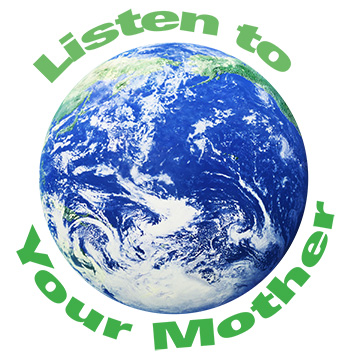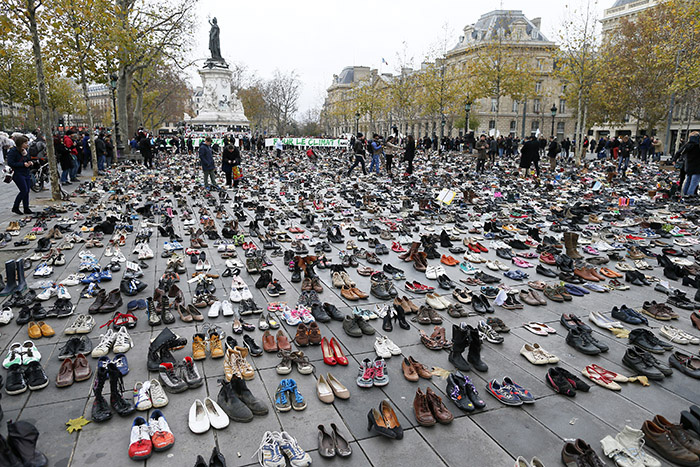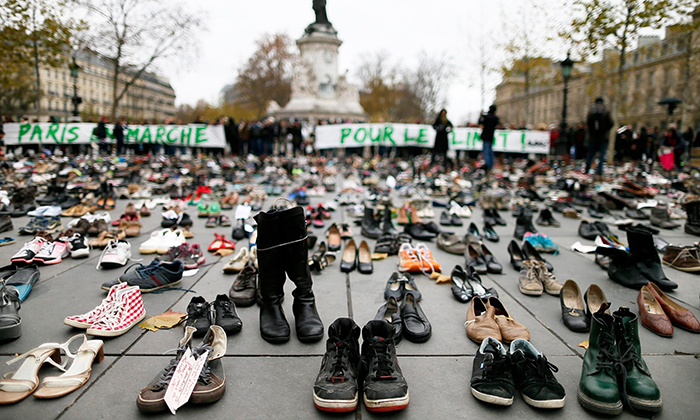After the Climate Talks: What’s Next for the Global Climate Movement? |
||
 |
On November 13, 2015, a series of coordinated terrorist attacks claimed by the Islamic State killed 130, mostly young people in Paris, with hundreds more injured, leaving Paris and all of France under a state of emergency. In the aftermath of these horrific killings, some thought the UN Climate Change Conference or COP 21 (Conference of the Parties) would be cancelled as the French government clamped down on its borders, deployed 3,000 additional police in Paris, and extended a state of emergency, which, among other things, banned public demonstrations (but not large gatherings like sporting events). In Paris, French foreign minister, Laurent Fabius, called off a huge march organized by international climate advocates Avaaz and 350.org that had been scheduled to mark the start of the talks. Public actions organized months in advance were cancelled as organizations worked to quickly contrive new and creative ways to make their presence felt at the talks. Paris organizers held all participants to a pledge of nonviolence and lined up acts of creative symbolism. Thousands of “marching shoes” were placed at the Place de la République, intended to show the commitment of the French people on climate change. |
|
| Pairs of shoes were laid out by the statue of Marianne, where, only weeks before, bouquets, candles, and messages commemorated the victims of the November terrorist attacks. Among them were sneakers from UN secretary general Ban Ki-moon and a pair of black shoes sent by Pope Francis.
So, why are these Paris climate talks more important than ones that have gone before, talks that have been notable mostly for their lack of international agreement and ineffective outcomes? And what inspired 195 countries to show up in Paris, despite the threat of terrorism, to hammer out an accord? The last UN climate summit, in Copenhagen, in December 2009, was, by all accounts, an utter failure, with countries walking out, no binding agreements reached, and only an encouragement for countries to make voluntary steps toward reducing their carbon emissions. “After Copenhagen, many world leaders believed that the United Nations process would no longer work for tackling climate change,” Secretary General Ban Ki-moon of the United Nations said in a New York Times interview (Coral Davenport, “A Climate Deal, 6 Fateful Years in the Making,” Dec. 13, 2015). “It was deeply disappointing. It was painful.” Davenport, in her article, identified three critical reasons: “a fundamental change in the geopolitics of climate change; a shift in the perception of global warming from a distant warning to an immediate threat; and the art of French diplomacy during the event and in the months beforehand to soften the sharp elbows of negotiators and reduce the chances that major points of contention might kill a deal again. In particular, they made sure that each country, regardless of its size or wealth, felt its voice would be heard.” The US agreement with China, brokered by Secretary of State John Kerry in November, 2014, also added an incentive for countries to make a serious commitment to the success of the Paris talks. Negotiators met the following month in Lima, Peru, to draft what would become the Paris agreement, the hallmark of which required each country to submit its own climate change plan before meeting in Paris. The moment French foreign Minister Laurent Fabius brought down the gavel to signal the adoption of an agreement and a formal close to the climate talks on December 12, 2015, many heralded this as an end to the era of fossil fuels, celebrating the agreement among all 195 countries as a major step forward. Davenport declared that the deal “represents a historic breakthrough on an issue that has foiled decades of international efforts to address climate change.”
|
||
Climate activists, however, decried that the nonbinding agreement with its voluntary pledges did not address critical issues, let rich countries that are most responsible for global carbon emissions off the hook, did not protect the rights of indigenous peoples, and lacked the financing needed to make a transition to a sustainable energy economy. As Guardian columnist George Monbiot noted (“Grand promises of Paris climate deal undermined by squalid retrenchments,” Dec. 12, 2015): “By comparison to what it could have been, it’s a miracle. By comparison to what it should have been, it’s a disaster.” Organizations like Bill McKibben’s 350.org saw the shortcomings of the Paris agreement as a call for climate activists to ramp up actions around the globe, targeting the fossil fuel industry to keep at least 80 percent of fossil fuels “in the ground,” in other words, leave these untapped reserves right where they are if there is any hope to keep temperature and sea-level rises to a place where the planet will continue to be habitable. McKibben says the biggest challenge the agreement faces is challenging the fossil fuel industry’s “supremacy.” So, what exactly does the agreement hold nations to and what are the big missing pieces? Responding to claims that a nonbinding agreement amounts to just another agreement on a shelf, Michael Burger, executive director of the Sabin Center for Climate Change Law at Columbia Law School, countered with the argument that public opinion and peer pressure within the international community can be effective. “The leaders of the world recognize that the consequences of noncompliance are disastrous. We are looking at a wholesale transformation of our global climate. Civil society has already played a large and important role in getting to this point. Now, environmental groups will take on the role of enforcer” (Climate Change News, Dec. 15, 2015).
|
||
1. The agreement sets a goal of limiting global temperature rise to below 2 degrees Celsius over preindustrial levels with general support for limiting warming to 1.5 degrees C. The 2 degree limit was acknowledged in Copenhagen in 2009 and has since been scientifically challenged as insufficient (Article 2, Section 1, UN Framework Convention on Climate Change, identifies temperature limits). But the carbon emission cuts in the Agreement are based on voluntary pledges (called Intended Nationally Determined Contributions or INDCs) that countries submitted before the talks. These pledges were based on what countries were willing to commit to, not necessarily what is equitable or what accepted scientific calculations would require. Taken in total, there remains a significant shortfall between what is being voluntarily pledged and what is necessary to slow down the warming of the planet. Some estimates, like MIT’s Climate Interactive, project a rise of more than 3 degrees C by 2100 if current voluntary current pledges alone are carried out. Climate Tracker offers a slightly more optimistic forecast, projecting a global temperature rise between 2.2 and 3.4 degrees C by 2100, if pledges are fully implemented. 2. The agreement seeks to peak global greenhouse emissions as soon as possible with a target of 2050, at which time it suggests counteracting all emissions with carbon sinks to remove greenhouse gases from the atmosphere. (A carbon sink is a natural or artificial reservoir that absorbs or stores carbon dioxide. Oceans and forests remove about a quarter of the carbon we currently emit.) Tokar claims “the Paris Agreement’s emphasis on sources and sinks represents a substantive step back from the goal of decarbonization and echoes the IPCC’s 2014 policy report, which promoted highly speculative carbon capture technologies as a means to compensate for continued fossil fuel use.” “The agreement’s lack of action on extraction could have catastrophic effects for many at-risk communities around the world,” says Alberto Saldamando, legal counsel for the Indigenous Environmental Network and a veteran of six years of COP negotiations. 3. Financing costs of climate change was, no surprise, a hot topic; unresolved in the agreement, it was kicked down the road to next year’s conference in Mexico. The Paris agreement includes no new specific commitments to financing, although Item 115 of the Paris decision says that more than that $100 billion will be needed. The document also uses language like “strongly urging” countries to meet their financial promises. Language on how global south countries would be compensated for damages to their environment was left voluntary. Tokar questions “how countries will be compensated for the continuing destruction of life-sustaining infrastructure in the face of accelerating warming. . . . With fossil fuel interests still dominating domestic politics in many countries, can the world settle for a diplomacy based mainly on cultivating a sense of moral obligation on the part of national governments and global corporations?” Tokar further noted that another gaping hole was “the omission of any steps to regulate rising pollution levels from international shipping and aviation.” Climatologists tell us this percentage of global emissions is growing rapidly. |
|
|
| 4. Enforcement and measuring progress are major challenges. How will countries verify reductions in emissions and be held accountable? The Agreement sets the first date for taking stock of progress as 2023, then every five years after. Item 20 also sets 2018 as a time for a dialogue to take place. Problematically, no body is established to hold countries accountable for their commitments.
Climate activists claim that it is pressure from their grassroots movements and indigenous groups that pushed the 195 countries to agreement, and that it is their job now to push for an end to the fossil fuel era. Martin Lukacs writing for the Guardian (“Claim no easy victories. Paris was a failure, but a climate justice movement is rising,” Dec. 14, 2015) notes that the first and biggest task is to keep reminding the wealthiest and most polluting countries of their commitments and to back up the rhetoric with actions: “a fledgling climate justice movement is no longer fighting merely against the carbon in the atmosphere, but the political and economic system that first emitted it there.” |
||
|
Speaking for 350.org, Jamie Henn acknowledged that the Paris Agreement targets fall short of what it will take to change course in time to avert the most disastrous effects of global warming. What the Paris Agreement can do is provide the backbone to demand a halt to any new fossil fuel project. 350.org will be focusing on an international Keep It in the Ground campaign, continuing the push for divestment from fossil fuels and adding a reinvestment focus toward a just transition to renewables. The National Catholic Reporter agreed that the Paris Agreement “lacked ambition” but offered a global framework from which to address climate change, “a road map for action,” and stated that “the Global Catholic Climate Movement in the next year plans to shift its focus from the international to the local, with more engagement of policymakers at the national and lower levels and the start-up of green parish and divest/reinvest initiatives.” One thing that has become clear is the power of local movements to compel change. In cities and countries around the world, grassroots campaigns are shutting down proposed pipelines, convincing states and universities to divest from fossil fuels, banning fracking, and championing the rights of indigenous groups. Communities of faith are joining with environmental groups to build coalitions and push for renewable energy solutions. The climate movement has become a mainstream force. |
|
“Nearly 200 nations were compelled to act on climate because there’s a global movement that has made action a political imperative,” says Lindsey Allen, executive director of the Rainforest Action Network. “Look at the elections in Alberta and nationally in Canada [in which oil industry favorites were ousted by candidates supporting clean energy] if you want evidence of the movement’s capacity to bring about political change.” While the gavel fell on the talks, thousands of activists rolled out 100-meter-long red banners signifying the climate red lines climate groups are prepared to draw to keep fossil fuels in the ground, to protect the rights of indigenous peoples, and to demand the resources to pay for losses caused by climate change, like loss of land and economic livelihood. Emma Ruby-Sachs, a campaign director at Avaaz.org, said after Paris, “We needed a North Star, we needed an agreement that was global that provided the path to the clean energy future. Now, it’s about us walking that path and bringing our governments along with us.”
|
||
|
K.C. Whiteley is the editor of “Listen to Your Mother.”
|
|

